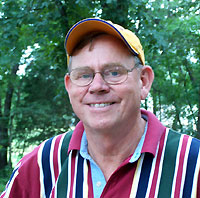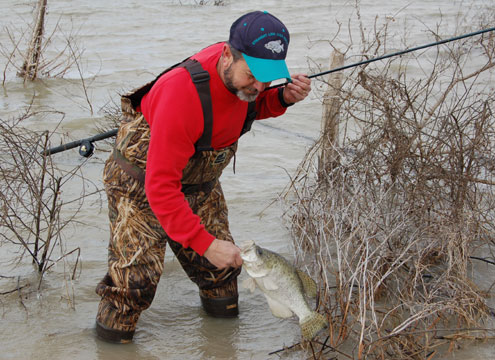
I’ve been keeping tabs on the water temperatures in the shallows on several lakes the past week and my sources are all telling me they’ve found water as warm as 60 degrees on sunny afternoons. In the mornings, the shallow water is chilled to the mid fifties but, from all accounts, about the time you’re reading this, the shallow water crappie bite will be on!
Jay Don Reeve, with CATS (www.crappieanglersoftexas.com) was on the water at Cedar Creek when I interviewed him for this article and he verified the morning water temperature in the shallows was 58 degrees.
“By afternoon, the water I’m now fishing should rise to the low sixties and that’s the trigger crappie need to move shallow," tips Reeve. "By the time your readers get this information, I’m predicting the shallow water bite to be on, big time.”
Reeve suggests fishing around standing beds of cattails or any shallow water cover that will attract spawning crappie.
“I like to fish with one-sixteenth ounce jigs under small floaters,” he added. “The best colors usually are black/chartreuse or black/pink. The water is usually stained this time of year and the darker colors usually produce better.”
Reeve suggests using a good jig pole, such as the B&M Pole, and drop the jigs vertically into heavy cover in water 2-3 feet deep.
“When the water is really off color," Reeve says, "it’s not uncommon to find spawning crappie in water as shallow as 12 inches but most are caught from depths of around 24 inches. “
Now is a great time for anglers without a boat to fish from the bank and enjoy great success. The same jig or live minnow fished under a light weight floater works for anglers fan casting from the bank.
Richland Chambers guide Troy Spruce with Guranteed Guide Service (www.nofishnocharge.com), says he’s caught lots of shallow water crappie by locating a good spot along the bank that provides easy access to cover and making repeated casts to the crappie attracting brush or reeds.
“The trick is to cast past the targeted cover and crank the jig back to the where you expect the fish to be,” explains Spruce. “When the bait reaches the cover, lightly twitch the rod tip causing the jig to move slowly to entice a strike.”
Spruce added that it’s also very common to catch crappie in what appears to be open water.
“Crappie are cruising the shallows this time of year, male crappie will actually ‘herd’ females into nesting areas," Spruce points out. "Keep tension on your line at all times, and be ready for that floater to disappear. What looks like open water from the surface often has submerged cover. A large area of cover is not necessary to attract spawning crappie. I remember last year about this time, a client and I pulled 10 barndoor crappie from around a single stick up situated near a retaining wall from water two-feet deep. When crappie find cover they like, they keep coming back to it.”
As a successful crappie angler, you’ll learn to repeatedly hit these likely bits of cover. It’s common to fish a spot, pull multiple crappie from it, then return in a couple hours and catch that many more.
Veteran crappie guide Billy Kilpatrick (www.straightlineguide.com) at Lavon says he often fishes his clients from the boat but when they are willing, he prefers wade fishing.
“There is no better way to sneak up on shallow water spawning crappie than by wade fishing," remarks Kilpatrick. "We catch a lot of crappie from the boat this time of year but if my clients are willing to put on a pair of waders, I always prefer wade fishing. I use the boat to get us to the hotspots then I tie the boat to some brush, we get into the water and actually stalk the crappie. It’s lots of fun and, very productive!”

Kilpatrick suggests using a floating fish basket to keep his catch rather than a fish stringer. Lightweight waders are often punctured by the fins of crappie kept on a stringer.
The fish basket floats easily along as we wade and it’s already handy,” he added.
Kilpatrick prefers using a 12-foot jig pole. Once he is in position, it’s possible to cover a 24 foot diameter circle.
“I remain as quiet as possible and drop the jigs vertically into the cover," Kilpatrick states. "If I don’t get a bite within thirty seconds, I then pull the bait straight up out of the water, this helps getting hung up on brush and loosing jigs. Even when using this technique, expect to lose tackle, especially if you’re fishing in the heavy cover where crappie spawn.”
Kilpatrick predicts the male crappie to begin moving into the shallows within the next few days and by the end of the month, and the females will shortly follow. But, as the guide mentioned, all crappie do not move shallow at the same time. The shallow water action that so many anglers look forward to usually continues through much of April.
Outdoor tip of the week: From recent reports, it appears the spring turkey breeding season is underway. John Bryan on the Holt River Ranch (www.theholtriverranch.com) in Palo Pinto County near Graford says he’s been watching gobblers strutting for the past week and hearing gobbling all over the ranch. “It appears our turkeys made it through the winter in good shape. We’re expecting a great spring season. For more information, call Bryan at 940-452-3415.
Mike Ford, on the Rio Rojo Rancho in Red River County, says there was an abundance of jakes last year and this spring, the birds are sporting beards.
“Gobblers have been sounding off for two weeks now," Ford says. "This country is still very wet from late winter rains but there’s plenty of pine knolls and higher meadows. I think that these areas will be the places to target this spring."
Contact Ford at 903-674-3750.
Red River County was the first East Texas county to receive stockings of eastern wild turkey several decades ago and this area has become the premier spot in eastern Texas to hunt them.